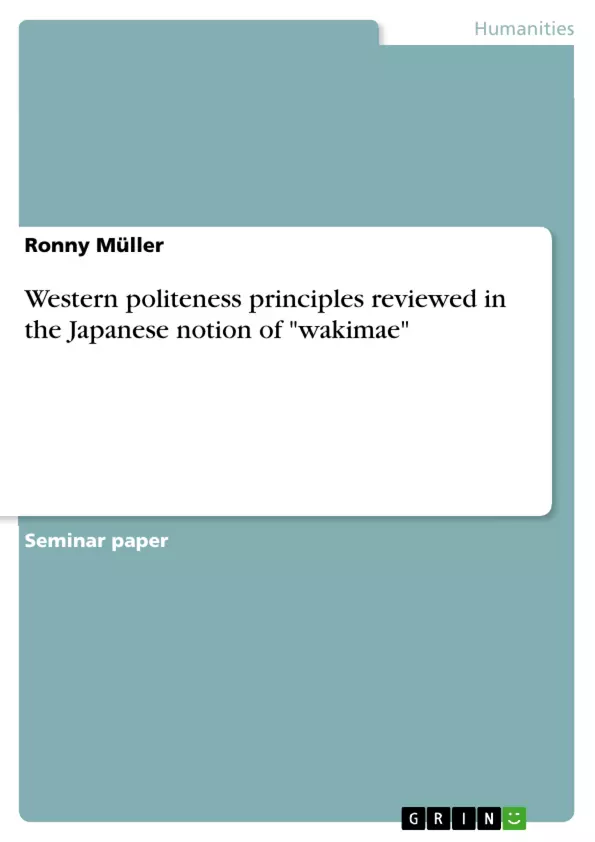Considering the term “polite” seems to be straightforward in our way of thinking today. However, to get to the bottom of politeness is not as easy as it appears at a first glance. The topic by itself and the principles beyond politeness are quite complex. To determine a general definition of politeness is desperately sophisticated. Politeness includes a great amount of subareas and distinct characteristics among a broad range of countries and cultures.
Given these points, Watts distinguished politeness research with “being in combat with a many-headed hydra”. Watts was on solid ground. Once you have separated one head of this hydra, all the more heads climb up instead. First of all, the spectator has to observe politeness research across-the-board. This fact by itself faces a huge and difficult challenge. Especially, if the observer keeps a close eye on issues related to politeness research. One of these subjects is the use of honorific forms in Western and Eastern societies. One conception beyond the usage of honorific forms was established by the Japanese sociolinguist Sashiko Ide (1989), who adjudicated the Japanese notion of wakimae as a conceptualization to define the usage of honorific forms across cultures.
The aim of this paper is to challenge the applicability of wakimae with reference to Western politeness principles. The first head of the hydra that has to be controlled deals with Western politeness principles. A brief glimpse of politeness research is provided because it is essential for the understanding of politeness research and Ide’s conception of wakimae. Current conceptions are predominantly based on these previous theories, labeled as first-wave approaches. Among first-wave approaches, the conception of Brown and Levinson was the most influential work in the field of politeness research. Correspondingly to first-wave approaches, a further head of the hydra appears in the field, the so called second-wave approach to politeness. After the clarification of first- and second-wave approaches, the conceptualization beyond East Asian and Japanese politeness enters the limelight. Another occurring and important head of the hydra is the notion of wakimae by itself. The end of this paper and the last head of the hydra are represented through a critical reflection of the Japanese notion of wakimae.
Inhaltsverzeichnis (Table of Contents)
- Introduction
- Brief Glimpse of Politeness Research
- First-wave Approaches
- Robin Lakoff
- Geoffrey Leech
- Brown and Levinson
- Conceptions Beyond First-wave Approaches
- Second-wave Approaches
- First-wave Approaches
- Politeness and East Asia
- Honorific Forms in Japanese
- Sachiko Ide and the Notion of Discernment
- Criticism Against Wakimae
- Eelen
- Pizziconi
- Cook
- Conclusion
Zielsetzung und Themenschwerpunkte (Objectives and Key Themes)
This paper aims to challenge the applicability of the Japanese notion of *wakimae* in relation to Western politeness principles. The paper explores the complexities of politeness research, particularly focusing on first-wave and second-wave approaches to understanding politeness. It investigates the conceptualization of *wakimae* by the Japanese sociolinguist Sachiko Ide and critically examines criticisms against this concept.- Western politeness principles
- First-wave and second-wave approaches to politeness
- The Japanese notion of *wakimae*
- Critical analysis of *wakimae* in relation to Western politeness
- Cross-cultural differences in politeness strategies
Zusammenfassung der Kapitel (Chapter Summaries)
- Introduction: This chapter introduces the complexity of defining politeness and highlights the challenge of studying cross-cultural variations in politeness, particularly focusing on the use of honorific forms in Western and Eastern societies. It introduces the Japanese concept of *wakimae* as a means to understand the use of honorific forms and outlines the paper's aim to examine the applicability of *wakimae* to Western politeness principles.
- Brief Glimpse of Politeness Research: This chapter provides an overview of key theories and concepts within politeness research, particularly focusing on first-wave approaches. It introduces influential works such as Robin Lakoff's three norms of politeness, Geoffrey Leech's principles of interpersonal rhetoric, and the influential work of Brown and Levinson. The chapter also briefly discusses second-wave approaches to politeness, highlighting their contemporary relevance.
- Politeness and East Asia: This chapter introduces the concept of honorific forms in Japanese and their significance in understanding Japanese politeness.
- Sachiko Ide and the Notion of Discernment: This chapter delves into the work of Sachiko Ide and her conceptualization of *wakimae* as a key aspect of Japanese politeness. It explains how *wakimae* relates to the use of honorific forms and the discernment required in navigating social situations.
- Criticism Against Wakimae: This chapter presents criticisms against the applicability of *wakimae* to Western politeness principles. It examines the arguments of Eelen, Pizziconi, and Cook, highlighting their perspectives on the limitations of *wakimae* as a universal concept.
Schlüsselwörter (Keywords)
This paper explores the key concepts of politeness, honorific forms, *wakimae*, first-wave and second-wave approaches to politeness, cross-cultural communication, and the complex relationship between language and social behavior. The paper also examines the critical perspectives of researchers like Eelen, Pizziconi, and Cook, who have challenged the universality of *wakimae*.- Citation du texte
- Ronny Müller (Auteur), 2014, Western politeness principles reviewed in the Japanese notion of "wakimae", Munich, GRIN Verlag, https://www.grin.com/document/284086



